Skip to content
DIY Tech & How-To / May 7, 2018 December 20, 2022
Brittney and her pup, Shawty (“Shorty” with a southern twang), tackle DIY motorcycle maintenance in their own garage together.
In WRN's do it yourself (DIY) section, we cover simple, affordable check-ups you can easily perform yourself that will keep your motorcycle safe and running well. You can find your bike’s service intervals and important bike-specific information in what we like to call M.O.M. That's your motorcycle owner’s manual. M.O.M. always has the answer!
In this article we will cover one of the most important parts of your bike—tires. Your motorcycle tires are the only things that make contact with the road when you’re riding, so it’s important to take good care of them.
Punctures can be present without a leak and are hard to notice without a good inspection.
Check your motorcycle’s tire pressure often, at least once a week, but better yet before every ride, even if you ride every day. If there is a significant change in air temperature overnight or between rides, there’s a good chance your tire pressure may have changed too.
Check the motorcycle tire pressure if you add a load or change elevation significantly and will be riding at the new elevation for more than an hour. For example, the difference between sea level and Big Bear Lake, California, is almost 8,000 feet and can be ridden in three hours.
Information on specs for motorcycle tire pressure will come from M.O.M. It might even be on a sticker on your bike's swingarm or frame.
Keep an eye on your tread wear as well, always making sure it has not yet worn down to the level of the wear bar (arrow). If the wear bar is level with the tire’s surface, it is time to replace it.
If you are unable to find a wear bar on your tire, you can measure the tread depth with a tread depth gauge or a simple ruler (if it fits).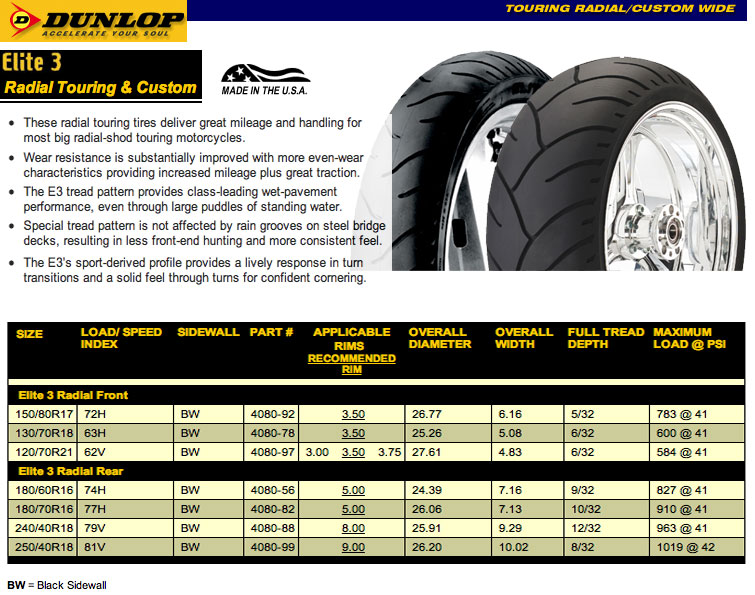
If you find an offending object that is embedded in place, if the tire is not losing air, cautiously ride to the nearest shop for inspection. Whether it is leaking or not, you may be able to get professional help to remove the object and repair the puncture on site. You may also be able to apply a tire patch to get you to the shop without leaving you stranded.
You can check if the puncture is causing a leak by spraying a small coating of Windex or soapy water (or saliva in a pinch) over the object or puncture wound and watch for bubbles. If there are no bubbles it is holding air.
If your bike’s tire pressure is high or low, simply release or fill with air until it is at the recommended pressure. It is normal for tire pressures to vary due to heat, elevation, and weather changes. So check often and maintain accordingly.
This portable MotoPump Mini Pro inflator gets power right from your motorcycle’s battery, and has a built-in LED light and backlit air pressure gauge which makes it easy to inflate tires on the go.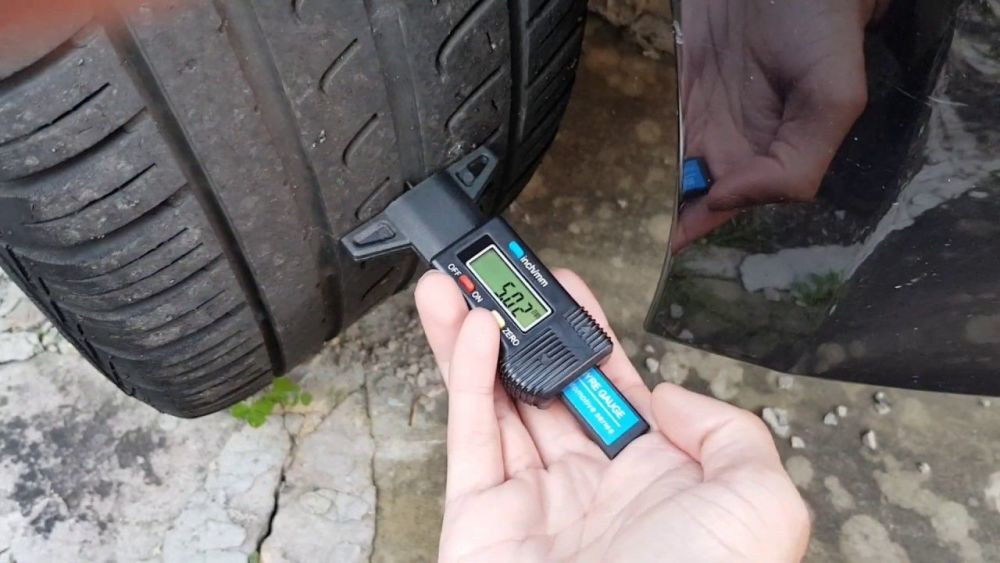
90-degree valve stems like this one allows for easy access when checking tire pressure and adding air. If your motorcycle doesn’t have one, they can be installed the next time you have the tires changed.
The general rule of thumb for tread wear is that anything less than 3/32” or approximately 2mm means it’s time to replace your tire.
This tire passes the top of Lincoln's head, passing the test.
Keep an eye on the age of the tires. Every DOT tire has an age stamp on the sidewall, indicating the week and year of manufacture.
This number represents the week and year of manufacture. This tire came to life on the sixth week (February) of 2016. Fun fact: the date stamp is always on the left side of the front tire and the right side of the rear.
A guaranteed safe age is less than two years for sport tires and less than three years for touring or cruising tires. This will change significantly between manufacturers and how you treat and store your bike.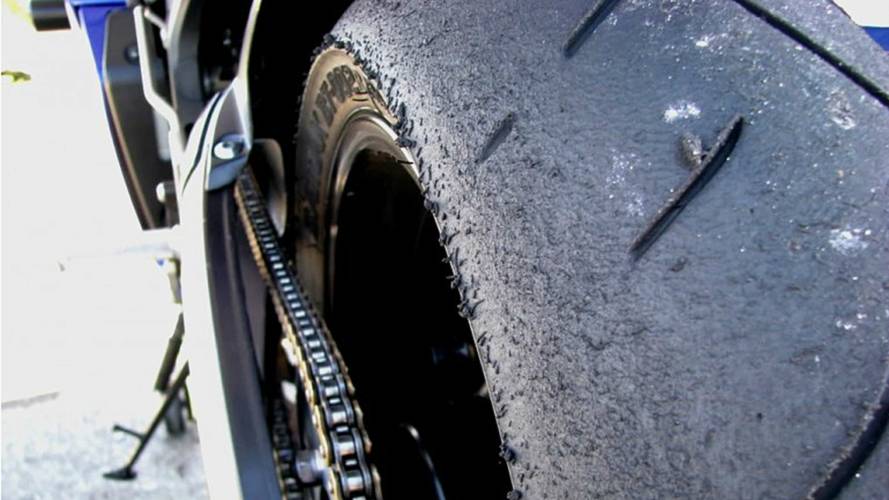 So use this information as a basic guide.
So use this information as a basic guide.
If your tire is beyond its age limit and you’ve confirmed this with the manufacturer, replace it. You never know what the inside of the tire looks like and dry rot can be an invisible danger.
If you find that you only need to replace one tire, you need to replace it with the same make and model of the tire. Tire tread patterns are engineered to work together, and mixing two different tread patterns and compounds can cause a dangerous situation. And please, for the love of riding, always select a motorcycle-specific tire!
Do not get overwhelmed by the overly-complicated size, load rating, speed rating, and compound explanations you might find on many online tire guides. What you really need to know can be explained in a few simple steps.
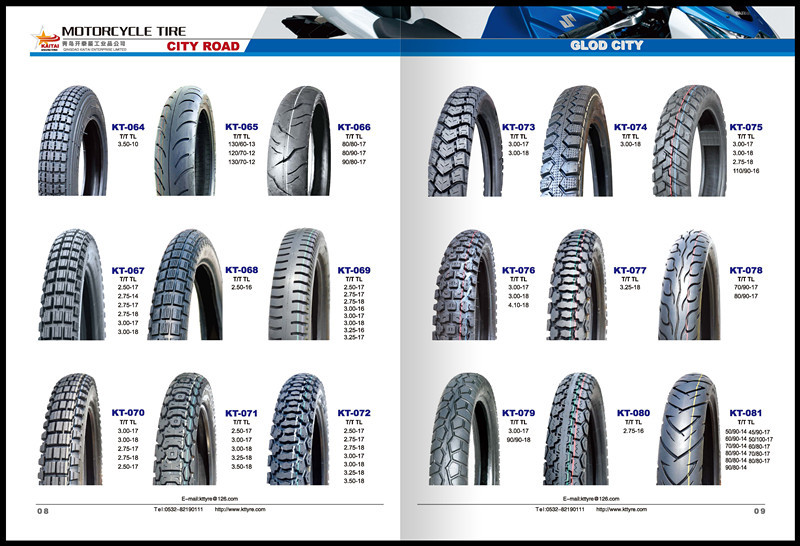
Many original equipment (OE) motorcycle tires were designed to work best on that very bike. So if you don’t know what tire to choose when it’s time to replace them, you can always stick with the OE tire.
Many shops or dealerships will charge extra (or won’t install them at all) if you buy the tires elsewhere and bring them in to be mounted. Don’t deny your local shop the opportunity to earn your business: shop for your tires there.
Don’t deny your local shop the opportunity to earn your business: shop for your tires there.
Falling prey to price: Online deals can seem too-good-to-be-true and are hard to pass up. Keep in mind, tire bargains from a warehouse could indicate a batch of old tires that they want to get rid of.
Longevity: meant to last as long as possible, usually requires a hard compound that heats up slower and doesn’t “melt” or wear down as quickly. Great for touring and cross-country riding.
Aggressive Profile: meant to maximize traction at excessive lean angles. Great for racing.
Multi-Surface: meant for riding both on and off the street with a ratio represented in percentages. For example, 70% street, 30% dirt. Great for exploring the wild outdoors.
Multi-Compound: meant to combine longevity (commuting or touring) and traction (curvy roads) by making the tire from rubber that is harder in the center and softer on the edges.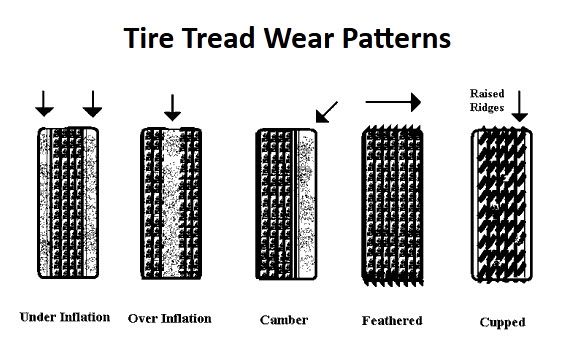 This means certain parts of the tire heat up faster/slower and have more/less traction and flex. Great for riders who commute every day and hit the twisties on their days off.
This means certain parts of the tire heat up faster/slower and have more/less traction and flex. Great for riders who commute every day and hit the twisties on their days off.
Like the saying goes, keep the rubber side down!
Sign Up Now
Spring is coming in hot, and that means almost time to break out the motorcycle and finally start enjoying yourself. As tempting as it may be to just jump right on and get rolling, that can be a deadly move if those tires haven’t been in service for an extended period of time. Tires are crucial safety components on a car; that's especially true on a two-wheel vehicle. And since you're probably likely to ride your motorcycle less than you drive your car (if that isn't true, then congrats on living the dream) you might run a bigger risk of using worn, outdated tires.
As tempting as it may be to just jump right on and get rolling, that can be a deadly move if those tires haven’t been in service for an extended period of time. Tires are crucial safety components on a car; that's especially true on a two-wheel vehicle. And since you're probably likely to ride your motorcycle less than you drive your car (if that isn't true, then congrats on living the dream) you might run a bigger risk of using worn, outdated tires.
Jumping on a bike with shot tires is a surefire way to wind up taking a ride you didn't sign up for. That's why you always want to give them a thorough inspection before your maiden voyage and keep an eye on them throughout the season. The good news is that the process of inspecting your motorcycle tires isn't unlike any other you've encountered before.
This quick refresh from The Drive’s gear crew is just what you need to get your head in the game. Let’s get into it.
The Drive and its partners may earn a commission if you purchase a product through one of our links. Read more.
Read more.
Time Needed: 10-15 minutes
Skill Level: Beginner
Cost: Possibly a new set of tires
We're inspecting motorcycle tires. It's not like you need power tools and torches to get the job done. If you do, you probably won't be riding the thing any time soon. That said, you still need to use your head a little to keep injuries at bay.
For the most part, you're just looking over the tires to spot any irregularities. You likely won't need to remove them from the bike to do so, but if you do, make sure to securely lift your machine before proceeding. Also, since there's a chance for sharp objects or frayed chords to rear their heads, it's best to throw on a set of protective gloves.
We’re not psychic, nor are we snooping through your toolbox or garage, so here’s a fresh list of what you need to get the job done.
Here’s what you need to do.
Before getting into the nitty-gritty, take a quick look over the entire tire and try to spot any signs of cracking or dry rot. Even if everything else checks out, this is a death sentence for the tires. It tells you the compound is starting to break down and the tire needs to be replaced ASAP.
Even if everything else checks out, this is a death sentence for the tires. It tells you the compound is starting to break down and the tire needs to be replaced ASAP.
The next most obvious thing you need to look for is any damage to the tire. Missing chunks, bulging in the sidewall, flat spots from sitting too long, excessive wear to the tread, and punctures are all things that tell you it's time to replace the tire.
If you find a puncture, you can opt to patch it yourself, but it's usually best to take the tire in for a professional replacement. Plugs and other solutions are generally temporary solutions meant to get you to a tire shop as soon as possible.
If there are no signs of dry rot, the next thing you want to do is inspect the profile of the tread.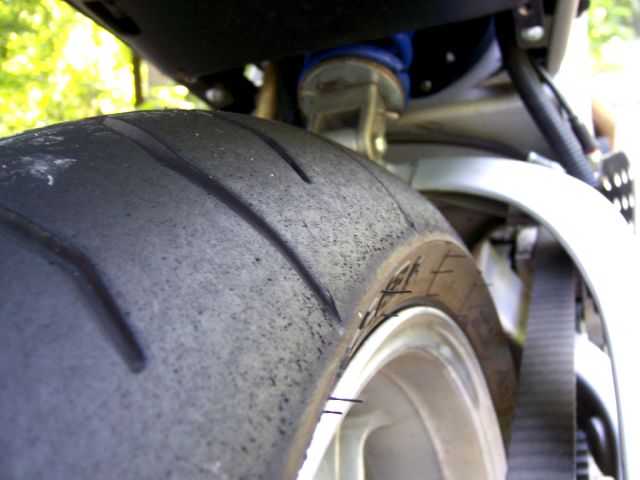 As a motorcycle tire reaches the end of its life, the tread will start to flatten out in the center. This is typically found on a worn rear tire, but its presence on either warrant tire replacement.
As a motorcycle tire reaches the end of its life, the tread will start to flatten out in the center. This is typically found on a worn rear tire, but its presence on either warrant tire replacement.
Be thorough when inspecting for a flat spot in the tread. If you find the flat spots kind of skip across the circumference of the tire, you're looking at what's called scalloping. This wear pattern is a symptom of faulty suspension components, which will need to be addressed along with the addition of fresh tires.
With all of that out of the way, you might be tempted to blast through the remaining steps and call it a day. Hold your horses. There's one more detail that'll make or break the deal. You'll find a series of numbers stamped into the sidewall following the DOT acronym.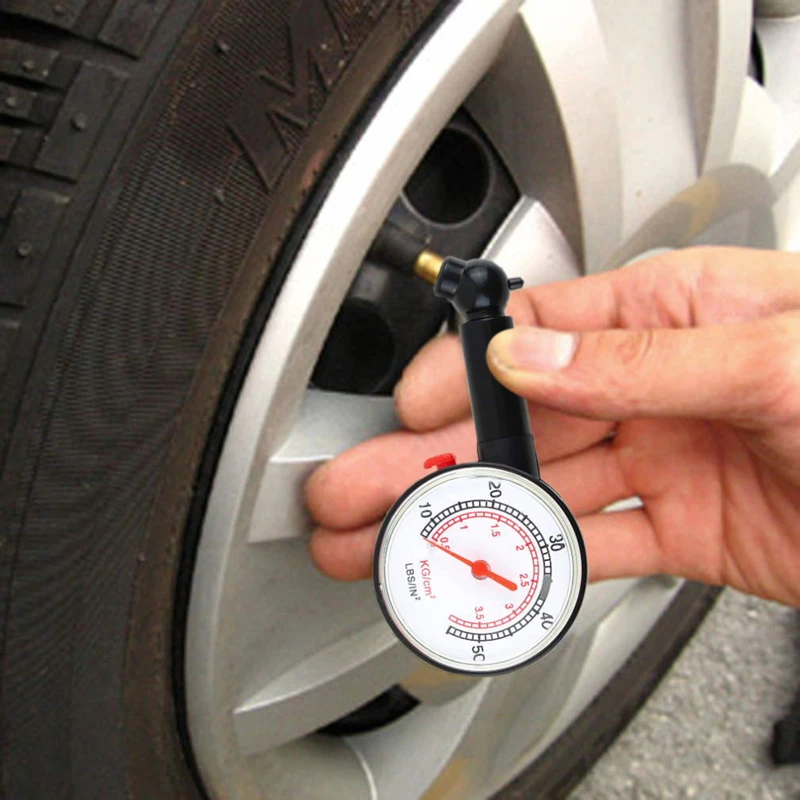 The final four digits in that series — which are usually circled — tell us when the tire was born. The first two digits are the week, and the final two are the year. Most motorcycle tires have a shelf life of around 7-10 years. If your tire's age exceeds that, you need to replace them, even if they appear to be in good shape otherwise.
The final four digits in that series — which are usually circled — tell us when the tire was born. The first two digits are the week, and the final two are the year. Most motorcycle tires have a shelf life of around 7-10 years. If your tire's age exceeds that, you need to replace them, even if they appear to be in good shape otherwise.
Now for the fun part. In order for a tire to be legal for street use, it needs to have at least 1/32 inch of tread depth. You need to take measurements from the center of your tire in several locations to verify. If you really want to science this out, grab a tire tread depth gauge. Otherwise, you can use a penny.
It just so happens that the top of Lincoln's head is about 2/32 of an inch from the edge. Place the edge of the penny with his head facing toward the inside of the tire between tread blocks.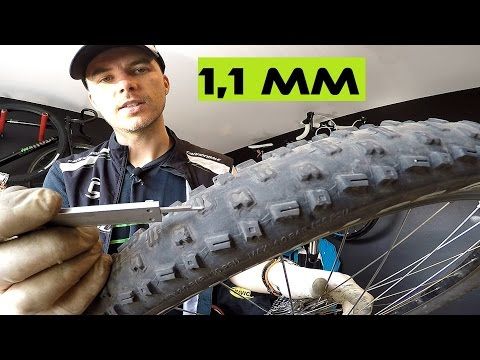 So long as his head is covered to any degree, you're within legal spec. If his head is only just slightly covered, consider replacing the tires in the near future. This is also a good opportunity to inspect the tire for any wear irregularities that aren’t as obvious to the naked eye.
So long as his head is covered to any degree, you're within legal spec. If his head is only just slightly covered, consider replacing the tires in the near future. This is also a good opportunity to inspect the tire for any wear irregularities that aren’t as obvious to the naked eye.
The last thing you need to do is check the tire pressure and make any necessary adjustments. Get that in check, and you’re ready to rock. Just make sure you fill the tire to the pressure given by the bike manufacturer on the spec sticker or owner's manual. The number on the tire's sidewall is the maximum allowable tire pressure. Filling the tire to that rating will cause you a lot of heartaches.
You’ve got questions.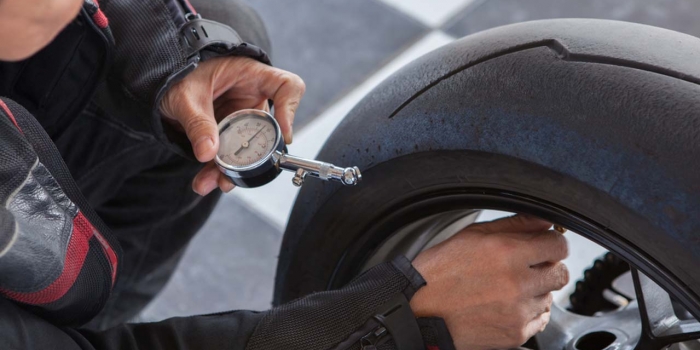 The Drive has answers.
The Drive has answers.
A. Most motorcycle tires have tread-wear indicators. They are cast between the tread blocks, sitting higher than the remaining low point. It's time to replace the tire when the tread sits flush with them. These are meant for a quick inspection, but they don't tell you the exact measurement of the remaining tread on a tire. It can also be hard to identify any existing tread-wear issues by reading these alone.
A. You might see racing bikes with a mix-matched set of tires, but this is not recommended on a street bike. You want consistent performance for safe on-road driving and should match your front and rear tires accordingly.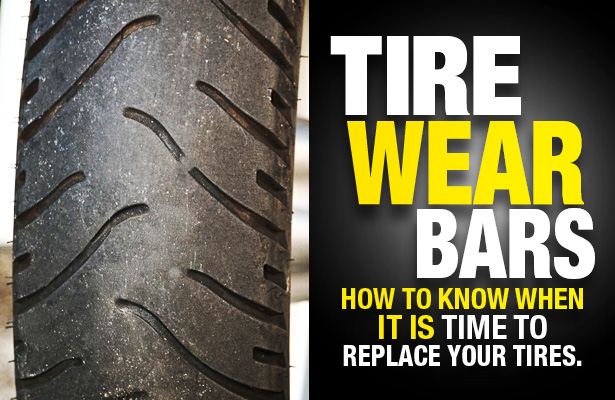
A. Yes. If you need to replace your tires, make sure to follow up with a proper break-in process. Breaking in the tires for the first few miles will scuff up the tread and give the tire the time it needs to settle out to perform as it's designed to.
We’re here to be expert guides in everything how-to related. Use us, compliment us, yell at us. Comment below, and let’s talk.
It's no secret that motor rubber is considered a consumable. Quite expensive, it must be said. We all remember from traffic rules tickets that motorcycle rubber wear is considered acceptable up to 0. 8mm. But not to run with a ruler around the motorcycle every morning? Moreover, rubber wear is different, because not only a worn tread is the reason for replacing motor rubber.
8mm. But not to run with a ruler around the motorcycle every morning? Moreover, rubber wear is different, because not only a worn tread is the reason for replacing motor rubber.
Consider the reasons for changing tires:
The first and main reason rubber is scrapped. Tire tread wear is determined visually by indicator pointers. On the tire, if you carefully inspect it, there are special marks inside the tread pattern. These tubercles are not a manufacturing defect, but that little thing that tells you that it is dangerous to use rubber further. When the tread pattern is even with the bump, you should buy a fresh tire. It's simple, you don't even need a ruler.
In fact, a tire wears out the fastest at two points in its life - during break-in and after tread wear. The smaller the pattern on the rubber, the faster it will become unusable, it is worse to keep the road and slide in every possible way on a wet surface.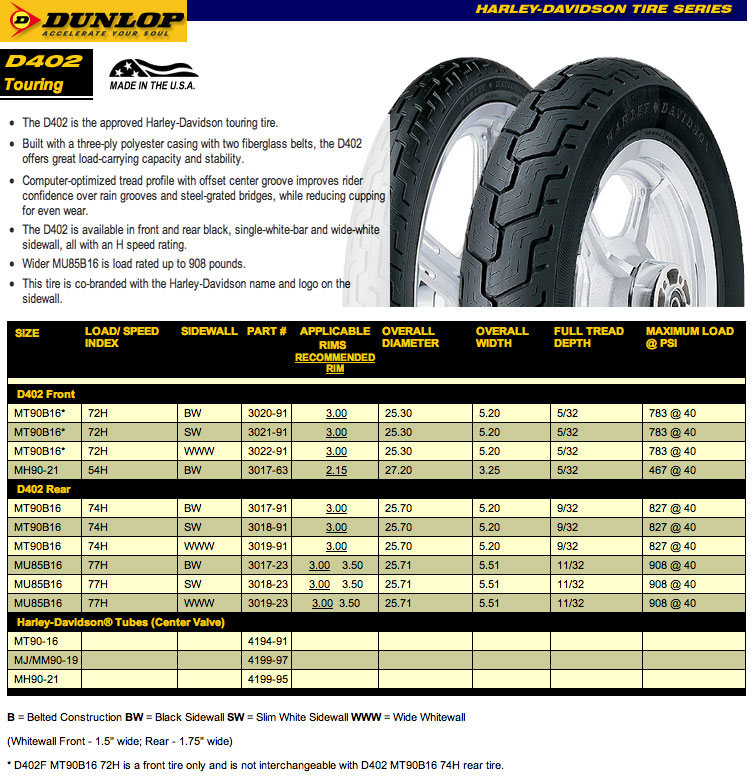 Just in case you think the rubber wears evenly and after the 0.8 mm critical point you still want to ride, I'll disappoint you, because after this point the rubber will begin to wear off at an amazing deserter speed.
Just in case you think the rubber wears evenly and after the 0.8 mm critical point you still want to ride, I'll disappoint you, because after this point the rubber will begin to wear off at an amazing deserter speed.
Cold tires wear out more slowly than warm tires. By the way, tires with lower pressure warm up faster, and therefore wear out more intensively. Low pressure affects wear at the edges of the tire, and high pressure contributes to abrasion in the center.
What did you think, bought a rubber, put it on and it will always be like new? Alas, nothing lasts forever under the moon, and even rubber is treacherously aging. The first signs that it is time for rubber to retire are cracks. Large or small, depends on storage conditions and how sad the tire is with life. Additional signs of the age of rubber - the color turns from black to gray, loss of elasticity, hardening and roughness of the surface.
It is logical that mechanical damage includes everything that has affected the rubber from the outside, the vast majority are impacts and punctures.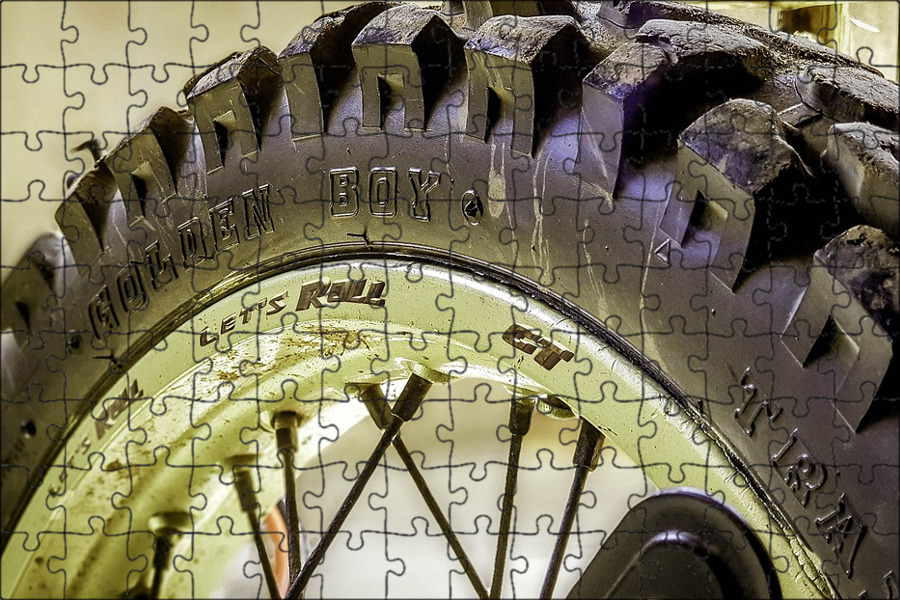 Riding habits, bad landings, even the influence of suspension settings can damage the integrity of the tire.
Riding habits, bad landings, even the influence of suspension settings can damage the integrity of the tire.
The combustion of rubber and spools should be considered as a separate point here. Since not every tire is used in light modes. Have you been to race tracks or demonstrations? If so, then you're familiar with the smell of burnt rubber, especially if you've watched someone drift. By spools, collected rubber in different parts of the tire, you can determine how the driver drove, especially true for track riders.
All damage that the rubber receives during storage, as well as in the process of uneven loading, is placed here. It happens that bulges appear on the tire, a sure sign that it's time to rest. Any deformation of the tire inevitably leads to a change in the distribution of force and to a shift in the contact patch, so such rubber will have to be changed to fresh.
In the "Want to Know" section #Want to Know we publish information about tires.
Riding safely depends on choosing the right tires, inspecting them regularly, checking their pressure, and replacing them on time.
***Inspection and maintenance***
.
Proper air pressure is essential for proper tire performance and service life. Under-inflating or over-inflating can result in poor braking performance, steering difficulties, internal damage due to excessive deflection, and rim separation. Pumping can reduce the contact area with the road (and therefore the braking force) and the harsh response to road bumps.
.
Tire pressure checks should be performed with cold tires (at least three hours from last ride), as part of your MANDATORY COMPLETE INSPECTION PRIOR TO LONG TRAVEL (RFID) and periodically at least once a week.
.
Refer to the Owner's Manual or the label on the frame of the motorcycle for the correct pressure for your motorcycle. There may be two sets of tire pressure recommendations (as well as suspension settings): for riding without a passenger and with a passenger and/or cargo.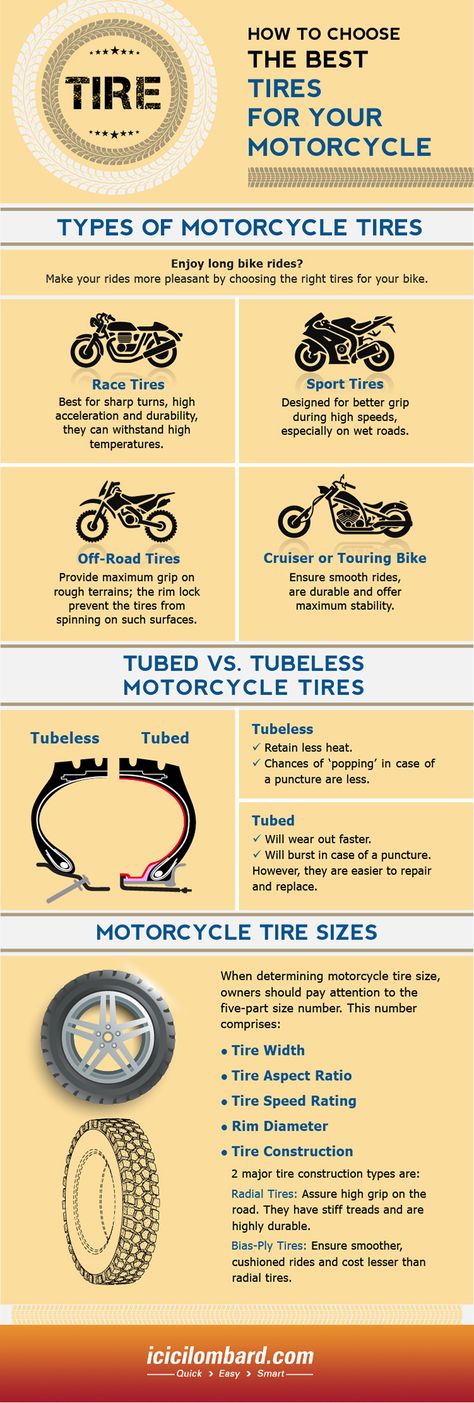 Do not exceed the maximum pressure indicated on the tire sidewall.
Do not exceed the maximum pressure indicated on the tire sidewall.
.
Never overload the motorcycle as this may damage the tires (See load limit calculator below).
Check the tread depth regularly. Tires have small wear marks in the tread grooves. When the tread wears down to the bar wear level (1/32 inch of tread remaining), the grooves wear out and the tire needs to be replaced. Some manufacturers recommend replacing tires when 2/32" or 3/32" of tread remains. Although it may seem that there is still enough tread thickness left, such tires perform poorly due to the fact that the drainage grooves have worn out and the risk of puncture due to tire thickness is increased.
For a quick check, insert a penny into the groove in the center of your tire, 2/32" is about where the crest begins. In addition to checking tread depth, inspect the tire surface for uneven wear, cuts, foreign bodies, sidewall bulges, and cracks.
Every time you drive, the tires go through a "thermal cycle", from ambient temperature to operating temperature and then cooling down again. Each such cycle gradually causes the tires to harden.
Each such cycle gradually causes the tires to harden.
Internal chemical reactions cause the tire to age and harden even if it has not been used. Tires absorb oil products from the road, which degrades the quality of rubber. Therefore, old tires need to be replaced, even if they have good treads. For the same reason, you should not buy used tires if, due to lack of experience, you cannot determine how many heat cycles they have gone through and what their age is.
.
This photo shows how water is squeezed out of a tire.
Rubber performs worse when cold than when hot. Tires are designed to provide maximum traction at specific temperatures. Drive moderately for the first few kilometers to allow your tires to come to the correct operating temperature. Professional racers use electric heaters to pre-heat their tires so they achieve maximum traction.
***Tyre selection***
.
The owner's manual for your motorcycle should list the tire size, type (radial or diagonal, tube or tubeless), load and speed range, and brand of tire installed as original. In addition, tires are divided into front and rear. Both front and rear tires must match each other in make and model. Tires must be installed in such a way that the side arrows correspond to the direction of travel.
In addition, tires are divided into front and rear. Both front and rear tires must match each other in make and model. Tires must be installed in such a way that the side arrows correspond to the direction of travel.
Motorcycle dealers can recommend different makes and types of tires that best suit your motorcycle and riding style.
The tread is designed to provide a resilient connection in the middle of the wheel for longer life in straight lines, and a soft connection on the outer edges for extra traction in corners. Note also that different tread patterns can affect how your motorcycle handles. For example, some models will work in the rain, cutting puddles.
Never fit car tires to a motorcycle. The car tire profile is not compatible with the motorcycle rim.
***Tire sidewall.***
.
Each tire must have a serial number on the sidewall. The serial number begins with the letters "DOT" and ends with four digits of the date code (if there are only three digits, the tire was made before 2000 and should be destroyed). The four digits indicate the week and year of
The four digits indicate the week and year of
production. For example, the code "4510" in the first photo means that the tire was produced in the 45th week of 2010. The sidewall will also have a code indicating the size, load index and speed index as shown in these examples.
The first number is the nominal tread width in millimeters, 160 mm in the second photo, 120 mm in the third. The second number is the ratio (ratio of tire tread height to width), which is given as a percentage. So for 160/60, the tire height is 60 percent of the tread width, or 96mm; for the 120/80, the tire height is 80 percent of the tread width, which also happens to be 96mm. Some tires use letter or inch designations instead of millimeters, as shown in the table.
.
In the second photo, "R" stands for radial layer construction.
The third "-" means offset.
"B" would mean diagonally belted.
Next comes the rim diameter in inches: 17 in the second photo, 18 in the third.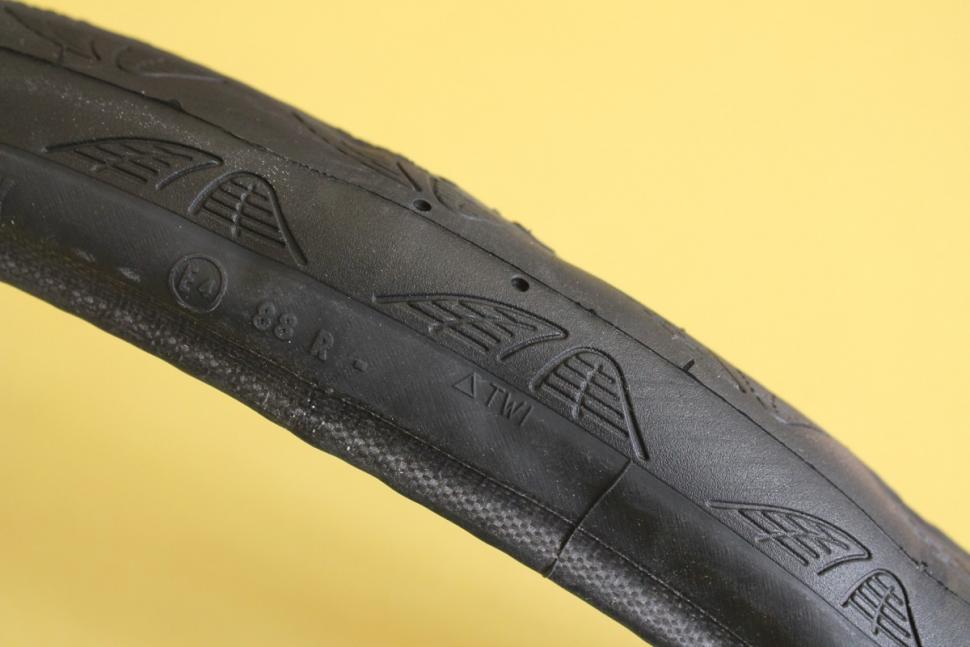
"M/C" indicates that the tires were designed for motorcycles
The following set of characters indicate the load index and speed index. "69" and "62" indicate how much maximum load the tire can carry (see Load Index Chart below) at speed, indicated by the speed index "(W)" and "H" respectively (see speed index table). Note that in the graph, W in brackets has a different meaning than W without brackets. Also note that tires with a "W" or "(W)" speed index are identified by the "Z" in front of the brand code in the tyre.
There are tires that are approved for public roads, designed for legal speeds, and there are tires that are only for use on certain high-speed European roads.
***Mount tire***
.
Tires must be replaced and balanced by a professional mechanic. Professionals have the tools to prevent damage to the tire bead, which must be pressed against the edge to provide an airtight seal, and they have the equipment that can do the balancing to protect the wheel from vibration. The rubber tube nipple must be replaced every time a tire is changed. New tires usually have a slippery surface. Do not overstress them for the first 200 kilometers so that the surface of the tire acquires a "scuff" and provides maximum grip. It will also give you time to adjust to them
The rubber tube nipple must be replaced every time a tire is changed. New tires usually have a slippery surface. Do not overstress them for the first 200 kilometers so that the surface of the tire acquires a "scuff" and provides maximum grip. It will also give you time to adjust to them
Since a motorcycle has a single track, unlike a car, motorcycle tires are completely different from car tires. While car tires have a fairly flat profile and contact patch, motorcycle tires have a U-shaped profile and contact patch, changing size and shape as they corner. Motorcycle tires are relatively narrow, which limits their ability to grip the road. In addition, grip is shared among several forces generated by braking, cornering and accelerating. The greater the angle of inclination when turning, for example, the less braking force. The faster you accelerate, the less grip you have on the ground. There are several reasons why the adhesion between the rubber and the road can be broken: the surface of the tire has lost its elasticity, due to low temperatures, aging, rainwater, engine oil, leaves, gravel, sand, mud, etc.